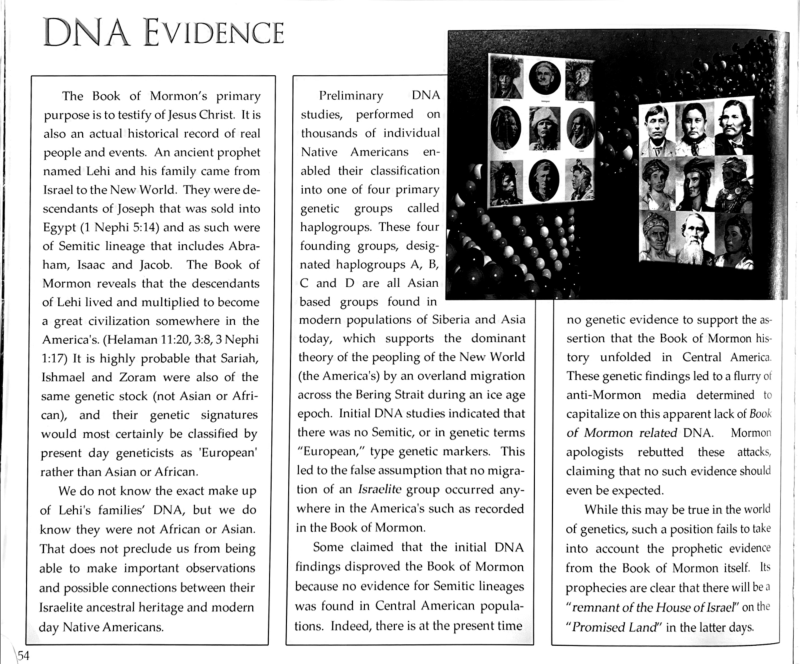Meldrum argues that DNA evidence locates the Lamanites in North America.
- Type
- Book
- Source
- Rod L. Meldrum LDS
- Hearsay
- DirectSecondary
- Reference
Rod L. Meldrum, Exploring the Book of Mormon in America's Heartland: A Visual Journey of Discovery (Honeoye Falls, New York: Digital Legend, 2011), 54–55
- Scribe/Publisher
- Digital Legend
- People
- Rod L. Meldrum
- Audience
- Reading Public
- Transcription
The Book of Mormon's primary purpose is to testify of Jesus Christ. It is also an actual historical record of real people and events. An ancient prophet named Lehi and his family came from Israel to the New World. They were descendants of Joseph that was sold into Egypt (1 Nephi 5:14) and as such were of Semitic lineage that includes Abraham, Isaac and Jacob. The Book of Mormon reveals that the descendants of Lehi lived and multiplied to become a great civilization somewhere in the America's. (Helaman 11:20, 3:8, 3 Nephi 1:17) It is highly probable that Sariah, Ishmael and Zoram were also of the same gernetic stock (not Asian or African), and their genetic signatures would most certainly be classified by present day geneticists as 'European' rather than Asian or African.
We do not know the exact make up of Lehi's families' DNA, but we do know they were not African or Asian. That does not preclude us from being able to make important observations and possible connections between their Israelite ancestral heritage and modern day Native Americans. Preliminary DNA studies, performed on thousands of individual Native Americans enabled their classification into one of four primary genetic haplogroups. These four founding groups, designated haplogroups A, B, C and D are all Asian based groups found in modern populations of Siberia and Asia today, which supports the dominant theory of the peopling of the New World (the America's) by an overland migration across the Bering Strait during an ice age epoch. Initial DNA studies indicated that there was no Semitic, or in genetic terms "European," type genetic markers. This led to the false assumption that no migration of an Israelite group occurred anywhere in the America's such as recorded in the Book of Mormon.
Some claimed that the initial DNA findings disproved the Book of Mormon because no evidence for Semitic lineages was found in Central American populations. Indeed, there is at the present time no genetic evidence to support the assertion that the Book of Mormon history unfolded in Central America. These genetic findings led to a flurry of anti-Mormon media determined to capitalize on this apparent lack of Book of Mormon related DNA. Mormon apologists rebutted these attacks, claiming that no such evidence should even be expected.
While this may be true in the world of genetics, such a position fails to take into account the prophetic evidence from the Book of Mormon itself. Its prophecies are clear that there will be a "remnant of the House of Israel" on the "Promised Land" in the latter days.
The Book of Mormon civilization did not consist of some small obscure village tucked neatly away in a remote location unknown to today's scientists, but rather they boldly covered the face of the land. (Mormon 1:7, 2 Nephi 9:53, 30:3-4, 3:2-3, 16, 23) Their prophecies state that their literal (genetic) "seed" or remnant would never be destroyed "according to the flesh" but that their latter-day descendants would be found to be of the "House of Israel" or the "Jews" in the latter days. This being the case, even with admixture from contemporary Asian civilizations that also inhabited the Americas, it seems logical that there would be some genetic remnant of the great and mighty Nephite and Lamanite peoples.
New DNA evidence suggests such a link in North America, but not in Central America, which has been speculated by some Book of Mormon geography students to have been the location where it occurred. A fifth founding genetic haplogroup was found among Native Americans to have ties to Europe, rather than Asia.
The five markers that delineate this group have been found throughout Europe and are known to be one of the 12 primary Jewish haplogroup lineages. This lineage is called haplogroup X and its origins are, according to geneticists, the "hills of Galilee" of the Holy Land in Israel. It has been found in many Israelite populations including the Ashkenazi, Sephardic, Libyan, Moroccan, Tunisian, and most importantly the Iraqi Jewish population that was removed from Jerusalem as slaves by King Nebuchadnezzar of Babylon (today Iraq) at 586 B.C. Therefore this lineage existed in Jerusalem during the time of Lehi. The results are remarkable for their implications evidencing the historicity of the Book of Mormon.
Ancient New World populations have now also been DNA sequenced with rather incredible new findings. Haplogroup X was subsequently found among the Algonquian speaking language groups of North America which include over 100 Native American tribes.
Anthropology professor Deborah Bolnick of the University of Texas-Austin authored a paper published in the American Journal of Physical Anthropology in 2008 detailing the results of her work sequencing DNA from the bones of the ancient Hopewell Mound Builders that were archaeologically removed in Ohio and Illinois. Her team found that these ancient people, whose highly advanced civilization thrived in a near perfect match with the Book of Mormon's Nephite civilization, did in fact have haplogroup X DNA. This establishes haplogroup X in the Americas during Book of Mormon time frames. This level of secular evidence is unprecedented.
- Citations in Mormonr Qnas
The B. H. Roberts Foundation is not owned by, operated by, or affiliated with the Church of Jesus Christ of Latter-day Saints.

